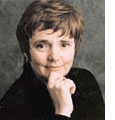Science and simplicity
By President Shirley
H. Showalter

“The guiding motto in the
life of every natural philosopher should be, Seek simplicity and distrust it.”
– Alfred North Whitehead
In mid-February, the world learned that human beings have remarkably few genes
– about double the number found in the fruit fly drosophila. According
to Eric Lander, director of the Whitehead Institute Center for Genome Research
in Cambridge, Mass., “There are many people who are bothered by the fact
that they don’t seem to have (many) more than twice as many genes as a
fruit fly. It seems to be some kind of affront to human dignity.” (Associated
Press).
This quote amused me, and I thought immediately
of Goshen College’s own expert on the drosophila, Professor Emeritus
Merle Jacobs. Anyone who has ever had the pleasure of listening to Merle explain
the intricacies of the fruit fly’s lifecycle would, instead of being affronted
by this comparison, consider we humans honored. We are simple creatures, made
of the same basic substances as all other creatures, yet able to adapt and invent
– seemingly without limits. For example, a skilled biologist can now find
a particular human gene in 15 seconds, compared to the laborious task that required
a decade of work when human genome research was in its infancy.
Like many other non-scientists, I enjoy reading about the amazing feats of the
men and women wearing lab coats, whether they be microbiologists, computer engineers,
or NASA explorers. Growing up in the Sputnik era, I used to fantasize about
going to the moon – my brother and I took our moonshots in peach baskets
powered by used oil filters. We also “discovered” oil on our farm
by drilling with tablespoons, and searched for larvae of rare and exotic butterflies
under milkweed leaves. Obviously, this approach to science failed to sustain
me beyond learning differential equations and the periodic chart of elements;
I took astronomy because I liked to gaze at stars, but I majored in English.
In midlife, however, the “two cultures,” as C.P. Snow dubbed science
and the humanities, have come closer together – not further apart –
in my own thinking and experience.
One of the greatest pleasures and advantages of the liberal arts college is
the opportunity to engage in discourse across disciplines. Academic Dean Paul
Keim has stimulated interest in such dialogue by encouraging various departments
to explain history and major issues within their disciplines to their colleagues.
Professors Todd Davis (English) and Mary Linton (biology) have gone beyond dialogue
with their peers to teach a course together on nature and poetry.
The texts selected by the general education
committee to guide our discussion of science and religion this year include
Wendell Berry’s Life is a Miracle. I recommend this book to anyone
interested in the ongoing dialogue between science and the humanities. Berry
proposes a radical idea: that instead of competing for dominance, the sciences
and the arts should subordinate their efforts to the simple question, “What
will this do to our community?” He commends the Amish for being wise enough
to ask this question.
I heard February’s news through this question of community welfare. On
the same day we learned that the human gene pool is much smaller than expected,
we also heard about an American spacecraft landing on an asteroid – an
achievement won against enormous odds. A third story told about astronauts on
the international space station, Destiny, who successfully hung a shutter to
provide an unparalleled view of Earth from space. Lessons from science taught
us, on the one hand, how simple human beings are at the basic level of creation,
and how complex we are at the highest levels of specialization.
The view of earth from space – the blue marble somehow able to contain
multitudes – was a powerful image from the last century. The challenge
of the present time is to focus our energies on the particular and the local,
seeking the simplicity that lies on the other side of complexity.

Return to April Bulletin
contents
Traces of God’s handiwork
in the universe by Rachel Lapp
Measurements
of God: The search for truth and beauty by Carl Helrich
Creating a community:
General education guides discussion by Ryan Miller with Beth Martin Birky
’83
The best of times,
the worst of times by Owen Gingerich ’51
Science and spirit, hand
in hand by Debra Brubaker ’79
Marrying science and religion, in classroom and
home interview with Elizabeth (Miller) ’51 and Marlin Jeschke
Return to Goshen College home page

